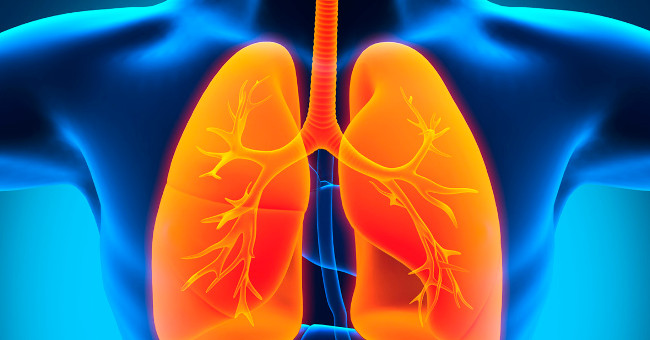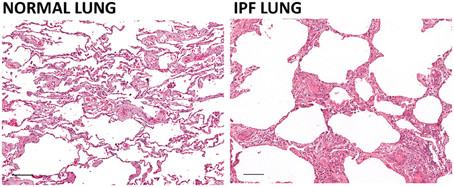Scientists successfully developed lung 'mini'
Researchers at Eli and Edythe Broad Research Center for Stem Cells and Regenerative Medicine, UCLA, have succeeded in creating three-dimensional "mini" lungs (organoid).
Lungs are important organs that help the body maintain life. Lungs start from the time we are born to death. Therefore, the operation of this apparatus is associated with our health. However, not everyone has healthy lungs. Along with lifestyle and other factors in life, make us more and more lung diseases. Researchers at the Eli and Edythe Broad Research Center for Stem Cells and Regenerative Medicine, UCLA, USA, created "mini" lungs. For the purpose of researching and providing appropriate therapies to treat lung diseases including idiopathic pulmonary fibrosis.

Image of human lungs.(Illustration).
The researchers coated small gel particles by lung-derived stem cells and then allowed them to assemble themselves into the shapes of air sacs in human lungs, which they succeeded in creating. "mini" lungs (organoid) three-dimensional (not a complete organ). Laboratory-grown lung-like tissue can be used to study diseases.
Although scientists have not built a fully functional lung. But they can take lung cells and place them in the exact geometric distance and model to mimic human lungs, to study diseases like idiopathic pulmonary fibrosis.Idiopathic pulmonary fibrosis is a chronic lung disease characterized by scarring (fibrosis) in the lungs. The scars make the lungs thick and hard, people with more difficulty breathing, lack of oxygen to the brain and vital organs. After diagnosis, most people with the disease live for 3-5 years. Idiopathic pulmonary fibrosis may be due to viral infection, a small percentage of genetics, smoking and exposure to some types of dust may increase the risk of developing the disease .

The image crosses the color of the normal lung and suffers from idiopathic pulmonary fibrosis under a microscope.(Photo: Frontiersin).
Previously, scientists studied the effects of gene mutations or drugs on lung cancer cells based on two-dimensional cell culture. However, when they took cells from people with idiopathic pulmonary fibrosis and replicated in a flat culture environment the cells seemed healthy. The absence of scars (fibrosis) - an important characteristic of the disease - in idiopathic pulmonary fibrosis cells in the laboratory makes it difficult to study biology and design treatments for diseases. towel.
Brigitte Gomperts and her colleagues started with stem cells created using cells from adult lungs. They used those cells to wrap the hydrogel particles, and then split them into small wells. Inside each well, lung cells grow around the particles, linking them and forming a evenly distributed three-dimensional model. To demonstrate that the small organoid mimics the actual lung structure, the researchers compared the tissues developed in the lab to the real parts of the human lung structure.

Cross section of lung tissue under a microscope.(Photo: UCLA Broad Stem Cell Research Center).
This technique is very simple, and can create thousands of organoid similar to the lungs and contain specific patient cells. Moreover, when the researchers added some molecular elements to the 3-D culture medium, these organoid developed scars similar to those seen in idiopathic pulmonary fibrosis, the impossible done by two-dimensional culture of these cells.
Using new organoid lungs, researchers can study the biological foundations of lung diseases including idiopathic pulmonary fibrosis, and at the same time test possible treatments for patients. To study the disease of an individual or what drugs work best in this case, doctors can acquire cells from humans, turning them into stem cells, turning cells The stem differentiates into lung cells, then uses these cells in 3-D culture. Because it is easy to create many small organoid at the same time, researchers can screen the effects of many drugs."This is the basis for accurate medicine and personalized medicine," said Brigitte Gomperts, head of the study.
- Cuba successfully developed a lung cancer vaccine
- For the first time successfully replicating human lungs
- Successfully transformed stem cells into lung cells
- New hope for people who need transplants: Successfully cultivate new lungs
- Japanese lung transplant successfully from live donors
- Reconnaissance aircraft from unique biodegradable material
- New breakthrough on early diagnosis of lung cancer
- Dogs have the ability to detect ... lung cancer
- Successfully cultivated mini human brains in the laboratory to try medicine
- Mini-rat brains in mice raise concerns about intelligent hybridization
- Discovered the ancient bird lung intact after 120 million years
- Treatment of lung cancer by inhaler
 Green tea cleans teeth better than mouthwash?
Green tea cleans teeth better than mouthwash? Death kiss: This is why you should not let anyone kiss your baby's lips
Death kiss: This is why you should not let anyone kiss your baby's lips What is salmonellosis?
What is salmonellosis? Caution should be exercised when using aloe vera through eating and drinking
Caution should be exercised when using aloe vera through eating and drinking Good news: New cancer drug discovered that causes cancer cells to 'starve'
Good news: New cancer drug discovered that causes cancer cells to 'starve'  Why do we get older when cells are always replicating?
Why do we get older when cells are always replicating?  Shocking Research: Human Memory Doesn't Exist Only in the Brain
Shocking Research: Human Memory Doesn't Exist Only in the Brain  Reasons for easy weight gain: Obesity has 'memory' and retains mechanisms in cells
Reasons for easy weight gain: Obesity has 'memory' and retains mechanisms in cells  What happens to cancer cells after they die?
What happens to cancer cells after they die?  New Breakthrough: 'Hack' Tumors, Turn Cancer Cells Into Pills
New Breakthrough: 'Hack' Tumors, Turn Cancer Cells Into Pills 